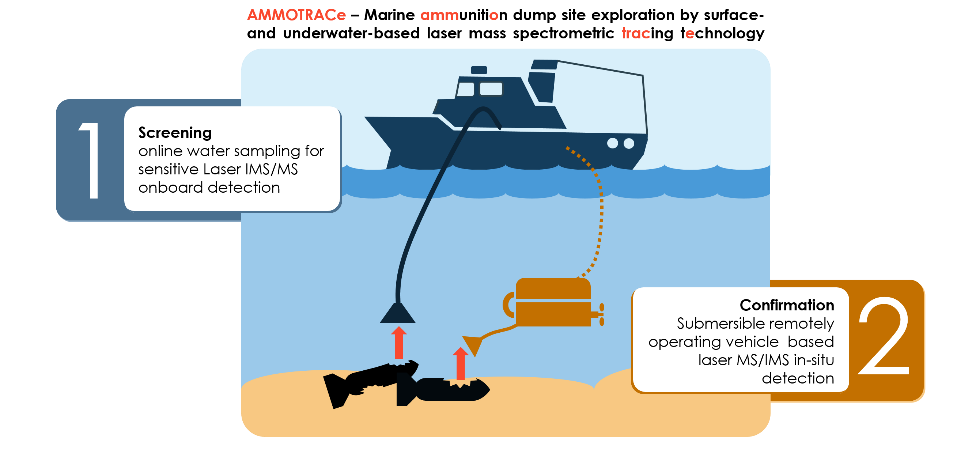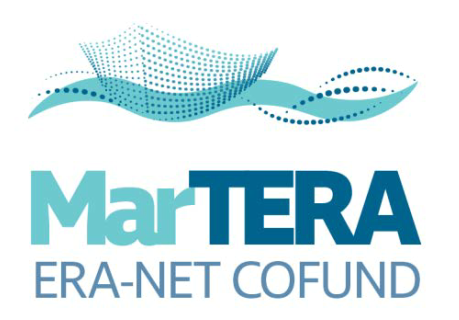AMMOTRACE
AMMunitiOn exploration by surface- and underwater-based laser mass spectrometric TRACing technology
Motivation
After WWI and WWII, large amounts of conventional and chemical weapons were dumped in European seas to eliminate the overwhelming quantities of war remnants. Today, European waters are strongly contaminated with underwater munition (UM), including hundreds of thousands of de-fused shells, mines, and aerial bombs. Furthermore, unexploded ordnance (UXO), sunken underwater mine barriers, and wrecks of military vessels carrying munitions contribute to the problem as well. It is estimated that the German portions of the North Sea and Baltic Sea alone contain approx. 1.6 Mio. tons of UM, which can be often found in relatively shallow waters, in areas of active fishing, or near major shipping routes. Today, all dumping sites represent a serious threat to marine environments, human activities, and seafood provision. Explosion risks, in particular, apply to increasing ship traffic and water sports in general as well as to intensified dredging and offshore work. Moreover, munition shells corrode over time, allowing the release of munition compounds (MC) as well as the slow alteration of explosive materials upon seawater exposure, making them more sensitive to detonation. Released chemicals associated with conventional explosives and chemical warfare agents have cytotoxic, genotoxic, and carcinogenic properties and can enter into the marine food chain up to human consumption. Therefore, safe, reliable, and cost-effective localization and clearance of UM in coastal waters are ecologically, economically, and socio-politically important. Commonly applied techniques for the localization of dumping sites include geophysical techniques, discrete sample collection with subsequent lab analysis, and chemical sensing technologies. However, despite the clear need for fast and reliable as well as in situ chemical detection technologies, successful methods for broad application remain unrealized.

AMMOTRACe is a transdisciplinary project, involving science, engineering, and companies across a range of disciplines to develop new solutions beyond disciplinary perspectives. The project aims to design, develop, prototype, and demonstrate complete technology solutions for new real-time ship-board and in‑situ analyzers for conventional and chemical MCs in coastal systems. For this, new laser photoionization mass spectrometers (PIMS), including latest laser developments as well as state of the art ion mobility spectrometers (IMS) will be combined with innovative membrane inlet (MI) sampling to provide highly selective and sensitive detection of MCs in marine systems. The key objectives of the project are as follows:
- Design and development of ship-board as well as a submersible PIMS/IMS prototypes for rapid and direct analysis of MCs in seawater
- Design and develop Nd:YAG-laser – optical parametric oscillator (OPO) systems with tuneable wavelengths as sources for photoionization, for ship-board and in situ submersible use
- Design and develop components and interfaces for the underwater deployment of the submersible PIMS/IMS device
- Demonstration of the prototypes alongside traditional chemical and geophysical measurements at munition dumping sites and regions with the presence of munitions.
Consortium
This project draws together European companies and research organizations that develop analytical techniques and instruments for environmental contaminant measurements, design and build hardware for underwater operations in marine systems, assess the presence of historic munitions in marine waters and sediments, and conduct underwater munition clearance operations
- GEOMAR Helmholtz Centre for Ocean Research (GEO, Germany)
- Institute for Baltic Sea Research Warnemünde (IOW, Germany)
- University of Rostock (UR, Germany)
- Institute of Oceanology Department of Marine Chemistry and Biochemistry (IOPAN, Poland)
- Photonion
- Innolas (IN, Germany)
- Dredging
- Environmental & Marine Engineering (DEME, Belgium),
- Centrum Techniki Morskiej (CTM, Poland).



